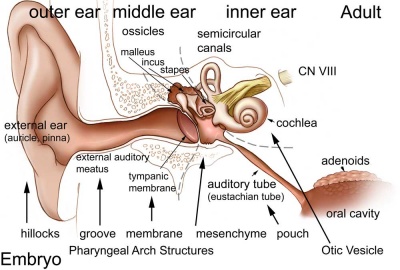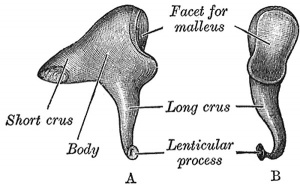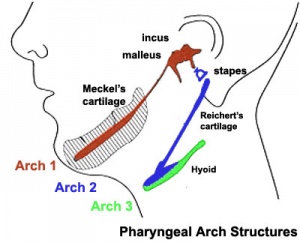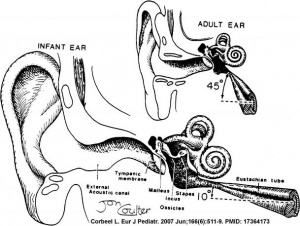Hearing - Middle Ear Development: Difference between revisions
| Line 43: | Line 43: | ||
|+ '''Adult Ossicle Anatomy''' | |+ '''Adult Ossicle Anatomy''' | ||
|-bgcolor="CEDFF2" | |-bgcolor="CEDFF2" | ||
| Component | | '''Component''' | ||
| Description | | '''Description''' | ||
| | |||
|- | |- | ||
| Head (capitulum mallei) | | Head (capitulum mallei) | ||
| large upper extremity of the bone, oval in shape | | large upper extremity of the bone, oval in shape | ||
| articulates posteriorly with the incus | |||
* being free in the rest of its extent | * being free in the rest of its extent | ||
* facet for articulation with the incus is constricted near the middle (consists of an upper larger and lower smaller part nearly a right angle with each other) | * facet for articulation with the incus is constricted near the middle (consists of an upper larger and lower smaller part nearly a right angle with each other) | ||
| Line 59: | Line 60: | ||
| Handle (manubrium mallei) | | Handle (manubrium mallei) | ||
| connected by its lateral margin with the tympanic membrane | | connected by its lateral margin with the tympanic membrane | ||
| directed downward, medialward, and backward | |||
* decreases in size toward its free end, which is curved slightly forward, and flattened transversely | * decreases in size toward its free end, which is curved slightly forward, and flattened transversely | ||
* medial side, near its upper end, is a slight projection, into which the tendon of the tensor tympani is inserted | * medial side, near its upper end, is a slight projection, into which the tendon of the tensor tympani is inserted | ||
| Line 70: | Line 71: | ||
| Lateral Process (processus lateralis; processus brevis) | | Lateral Process (processus lateralis; processus brevis) | ||
| a slight conical projection from the root of the manubrium | | a slight conical projection from the root of the manubrium | ||
| directed laterally, and is attached to the upper part of the tympanic membrane | |||
* by means of the anterior and posterior malleolar folds, to the extremities of the notch of Rivinus. | * by means of the anterior and posterior malleolar folds, to the extremities of the notch of Rivinus. | ||
|-bgcolor="F5FAFF" | |-bgcolor="F5FAFF" | ||
Revision as of 10:17, 20 May 2011
Introduction
The middle ear bones (ossicles) are derived from first and second arch mesenchyme and the space in which these bones sit is derived from the first pharyngeal pouch.
Some Recent Findings
|
Ossicles
Middle ear development begins closely associated with head formation and involves both the foregut tube (pharynx) and the pharyngeal arches. Pharyngeal arches form the main anatomical structures of the head and neck, including all components of the middle and outer ear.
The three middle ear bones or auditory ossicles (malleus, incus, stapes) are formed from the cartilage template found within pharyngeal arch 1 and 2. These bones are commonly named the hammer (malleus), anvil (incus) and stirrup (stapes), and the cartilage bands are historically named after two German anatomists and are called Meckel’s cartilage (first pharyngeal arch; named after Johann Friedrich Meckel, 1781–1833) and Reichert’s cartilage (second pharyngeal arch; named after Karl Bogislaus Reichert, 1811–1883). There are several theories as to how each arch cartilage contributes individual components of the middle ear ossicles. For example, a recent study suggests a mesenchymal origin for the stapes rather than directly from Reichert's cartilage.[2] Meckel’s cartilage first appears histologically at Carnegie stage 16 and Reichert’s cartilage slightly later.
The early stages of auditory ossicle development all occur within the solid mesenchyme of the pharyngeal arches until the eighth month of development, then within a fluid-filled space for the final month, and finally only postnatal in the neonate in the air-filled tympanic cavity. This transition in auditory ossicle environment means that the middle ear does not function correctly until after birth, and any prenatal conduction to the cochlea must be mediated through bone conduction.
During development of the tympanic cavity, the auditory ossicles are held in their correct anatomic positions by supporting ligaments. Arch cartilages ossify by the process of endochondral ossification, where a pre-existing cartilage template is first formed and later replaced by bone. Endochondral ossification is the main process of bone formation throughout the entire skeleton, except for the cranial vault and the clavicle that ossify by a process of intramembranous ossification.
Initially, the malleus and incus form as a single structure, and it is only later that they separate to form two separate bones. Ossification continues through the entire fetal period, and the newly formed bones also have a transient bone marrow cavity. The marrow cavity is still present at birth, in both the malleus and the incus, and with continued ossification is lost during the first two years after birth. Postnatally, first the malleus and then the incus lose their marrow spaces.
Malleus
|
Malleus (left) A. From behind. B. From within. |
This ossicle was named from its resemblance to a hammer. The structure of the adult bone can be divided into a head, neck, and three processes (manubrium, anterior and lateral processes). In the fetus, of the three processes the anterior process is the longest and is in direct continuity with Meckel's cartilage. |
| Component | Description | |
| Head (capitulum mallei) | large upper extremity of the bone, oval in shape | articulates posteriorly with the incus
|
| Neck (collum mallei) | narrow contracted part, just beneath the head
| |
| Handle (manubrium mallei) | connected by its lateral margin with the tympanic membrane | directed downward, medialward, and backward
|
| Anterior Process (processus anterior (Folii); processus gracilis) | delicate spicule from the eminence below the neck
| |
| Lateral Process (processus lateralis; processus brevis) | a slight conical projection from the root of the manubrium | directed laterally, and is attached to the upper part of the tympanic membrane
|
| (some text modified from Gray's Anatomy) |
Middle Ear Muscles
The middle ear also contains the two smallest muscles of the body, the stapedius and tensor tympani muscles, which both differentiate from arch mesenchyme. These muscles form and differentiate in a similar fashion to other developing skeletal muscle. Initially myoblasts proliferate under the influence of growth factors in the region of where the muscle will form. Myoblasts are the embryonic undifferentiated single cells of all skeletal muscles.
- The adult tensor tympani is classed as a mixed muscle containing slow (type 1) and fast (type 2A, and probably 2X) muscle fibers.
- The adult mammalian stapedius muscle contains mainly (77%) fast oxidative glycolytic type muscle fibers and the avian muscle only contains fast fibers.
A recent study[3] of the stapedius muscle development in 50 human embryos and fetuses between 38 days to 17 weeks post-conception identified 2 origins
- for the tendon - derives from the internal segment of the interhyale
- for the belly - located in the second pharyngeal arch, medially to the facial nerve and near the interhyale
interhyale - term describing the internal part of the second pharyngeal arch that forms the tendon of the stapedius muscle
Tympanic Cavity
The auditory tube, eustachian tube (named after Bartolomeo Eustachi, 1500–1574), otopharyngeal or pharyngotympanic tube develops from the first pharyngeal pouch and is lined with endoderm. This narrow cavity links the pharynx to the middle ear and is continuous with the tympanic cavity. The auditory tube has two main functions: ventilation, to allow the equalization of pressure in the middle ear, and clearance, to allow the middle ear fluid continuously produced by the epithelial lining to drain from the middle ear.
In normal human development, the auditory tube has an almost straight posterolateral to anteromedial pathway. The main growth of the auditory tube occurs in extension and lumen of the cartilaginous portion in the fetal period between weeks 16 to 28.
At birth, and in the young child, the tube is both shorter (8-9 mm) compared to the adult length (17-18 mm), runs almost horizontal and is narrower in diameter. Head growth in the child to adult size results in a longer wider tube that runs at approximately 45 degrees to the horizontal. The auditory tube is also normally closed and is opened by muscles—in the infant this is only a single muscle, the tensor palati muscle. In the adult the auditory tube is now opened by two separate muscles, the tensor palati and levator palati muscles.
he middle ear cavity or tympanic cavity is formed by an expansion of the pharynx. The initial early cavity lining is formed by the pharyngeal endoderm epithelium. The epithelium will then continue to expand, to eventually also line the entire mastoid antrum.
- derived from first pharyngeal pouch
- extends as tubotympanic recess - during week 5 recess contacts outer ear canal
- mesoderm between 2 canals forms tympanic membrane
- expands to form tympanic recess
- stalk of recess forms auditory tube(eustachian tube, pharyngotympanic tube)
Auditory Tube
(Eustachian, otopharyngeal or pharyngotympanic tube)
Connects middle ear cavity to nasopharynx portion of pharynx. Tube is normally closed and opened by muscles.
- Ventilation - pressure equalization in the middle ear
- Clearance - allow fluid drainage from the middle ear
Postnatal Changes
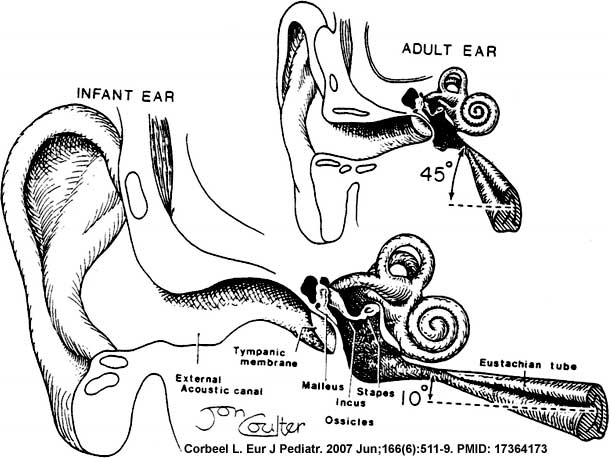
|
Adult
|
Adult Middle Ear
The adult middle ear, like the inner ear, eventually will lie within the petrous portion of temporal bone. Initially, both the middle and inner ear form within mesenchyme, embryonic connective tissue, forming the otic capsule, and this will also form the base of the skull. The mesenchyme differentiates first to form cartilage, forming a structure known as the chondrocranium. This initial cartilage is gradually replaced by bone forming at a number of sites within the cartilage, ossification centers. The initial bone that is formed also contains marrow spaces that disappear with ongoing ossification (Yokoyama et al., 1999). Between the weeks 16 to 24, centers of ossification appear in the remaining cartilage of the otic capsule, and these continue to ossify to eventually form mastoid process of temporal bone.
Ossicles
- develop from first and second pharyngeal arches
- tympanic cavity enlarges to incorporate
- coats with epithelia
- first arch mesoderm
- tensor tympani muscle
- malleus and incus
- second arch mesoderm
- stapedius muscle and stapes
Middle Ear Genes - gooscoid, RARs, Prx1, Otx2, Hoxa1, Hoxb1, endothelian related molecules
Additional Images
References
Reviews
<pubmed>21196256</pubmed>
Articles
<pubmed>21285435</pubmed>
Search PubMed
May 2010 "Middle Ear Development" All (2368) Review (226) Free Full Text (272)
Search Pubmed: Middle Ear Development | Ossicle Development | Malleus Development | Incus Development | Stapes Development
External Links
- Neuroscience Neuroscience - The Middle Ear
Glossary Links
- Glossary: A | B | C | D | E | F | G | H | I | J | K | L | M | N | O | P | Q | R | S | T | U | V | W | X | Y | Z | Numbers | Symbols | Term Link
Cite this page: Hill, M.A. (2024, May 2) Embryology Hearing - Middle Ear Development. Retrieved from https://embryology.med.unsw.edu.au/embryology/index.php/Hearing_-_Middle_Ear_Development
- © Dr Mark Hill 2024, UNSW Embryology ISBN: 978 0 7334 2609 4 - UNSW CRICOS Provider Code No. 00098G
